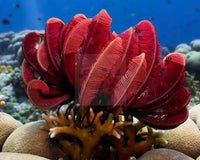The deep blue sea is often described as one of the most enigmatic places on Earth. With more than 80% of the ocean remaining unexplored, it harbours an array of life forms that continue to baffle and intrigue scientists and explorers alike. From luminescent jellyfish to colossal squid, the mysterious creatures of the deep blue sea hold profound secrets that captivate our imagination. This blog post aims to delve deeper into this fascinating underwater world, highlighting its mysteries and the incredible biodiversity that resides within.
The Depths of the Ocean
The ocean is divided into different zones based on depth, light penetration, and other factors. The surface layer, or the photic zone, extends down to about 200 meters, where sunlight can penetrate. Below this lies the twilight zone, which ranges from 200 meters to 1,000 meters. Here, light diminishes rapidly, and temperatures drop significantly.
Beyond the twilight zone is the dark abyss, extending down to the ocean floor and reaching depths of 11,000 meters in the Mariana Trench, the deepest known point on Earth. These depths are home to some of the most mysterious creatures, adapted to an environment with high pressure, dark conditions, and cold temperatures.
Mysterious Creatures of the Deep Blue Sea
The deep blue sea is teeming with astonishing life forms. Many creatures exhibit unique adaptations that enable them to thrive in such harsh conditions. For instance, the anglerfish, a deep-sea predator, is known for its bioluminescent lure that attracts unsuspecting prey. Its grotesque appearance and hunting mechanism have made it a fascinating subject for researchers.
Another remarkable inhabitant is the giant squid, a creature that has inspired myths and legends throughout history. Once thought to be mere folklore, the giant squid’s elusive nature and formidable size have only recently been documented in their natural habitat.
While some deep-sea residents such as the jellyfish are well-known, others remain less understood. The enigmatic vampire squid, capable of surviving in low-oxygen environments, showcases the resilience of life in the depths of the ocean.
The Role of Hydrothermal Vents
One of the most astonishing discoveries in the deep blue sea is the presence of hydrothermal vents. Discovered in 1977, these fissures release heated water rich in minerals and support entire ecosystems independent from sunlight. Organisms such as tube worms, which rely on chemosynthesis rather than photosynthesis, thrive here. These vents demonstrate the incredible adaptability of life and challenge our traditional understanding of biospheres.
The Importance of Biodiversity
Biodiversity in the deep blue sea is crucial for maintaining ocean health. Each species plays a specific role in its ecosystem. For instance, larger predators help control populations of smaller fish, while smaller species contribute to nutrient cycling. The loss of a single species can have ripple effects throughout the ecosystem, leading to unforeseen consequences.
Furthermore, many deep-sea creatures possess unique biochemical properties that have potential applications in medicine and environmental science. The exploration of these creatures could unlock breakthroughs in various fields such as pharmaceuticals and biotechnology.
Challenges in Deep Sea Exploration
Despite advances in technology, exploration of the deep blue sea remains a daunting challenge. High pressures, freezing temperatures, and vast distances complicate the collection of data. Submersibles and remotely operated vehicles (ROVs) have opened new frontiers in deep-sea research, allowing scientists to capture previously unseen behaviours and habitats.
Yet, the vastness and complexity of the ocean mean that we are merely scratching the surface. Ongoing exploration is essential to uncovering the myriad of species yet to be discovered and to understanding the intricate relationships within these ecosystems.
Conservation Efforts
As we delve deeper into the mysteries of the deep blue sea, it becomes increasingly vital to implement effective conservation strategies. The threats posed by climate change, pollution, and overfishing can have devastating impacts on marine life. Protecting these ecosystems ensures the survival of the deep sea’s unique inhabitants.
In recent years, there has been a growing movement to establish marine protected areas (MPAs) that safeguard habitats from human interference. By limiting fishing and conserving ecosystems, we can help to maintain the health of the ocean and preserve its wondrous biodiversity for future generations.
Conclusion
The deep blue sea remains one of the last frontiers on Earth, full of secrets waiting to be uncovered. The extraordinary creatures of the deep continue to inspire awe and wonder, pushing the boundaries of our understanding of life. As we learn more about these mysterious beings and their habitats, we must also commit to protecting their environments to ensure their survival. The deep blue sea holds not only ecological significance but also untold opportunities for advancements in science and medicine. By embracing this challenge, we can ensure that the marine wonders of our planet endure.
Bringing a bit of sea life to you www.marineworldaquatics.co.uk




